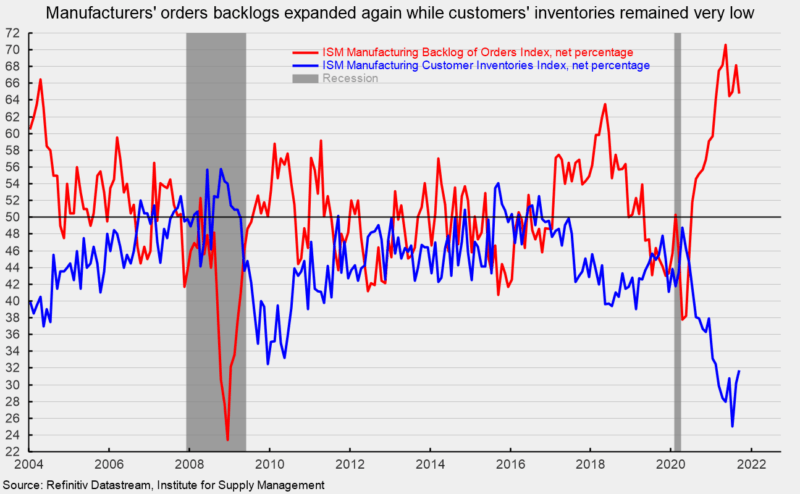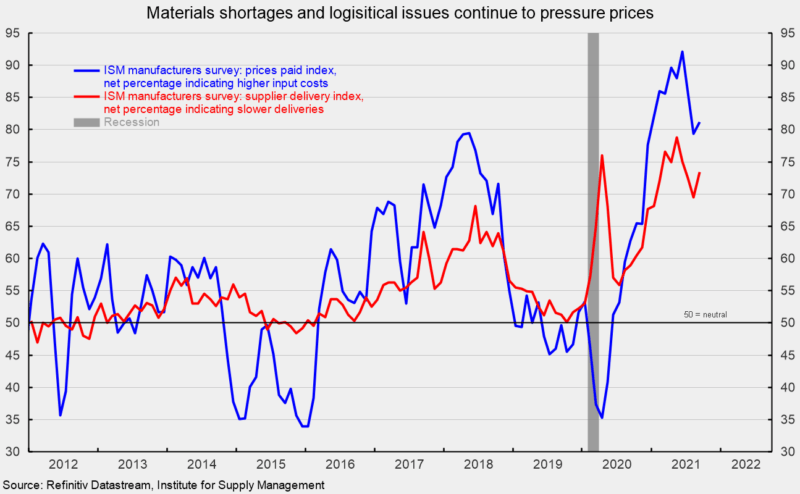The Institute for Supply Management’s Manufacturing Purchasing Managers’ Index rose to 61.1 in September, up 1.2 points from 59.9 percent in August. September is the 16th consecutive reading above the neutral 50 threshold and is the seventh month above 60 in the last 10 months (see top of first chart). The survey results suggest that the manufacturing sector continues to expand at a robust pace.
Among the key components of the survey, the New Orders Index held at a very strong 66.7 percent in August (see top of first chart). The New Orders Index has been above 50 for 16 consecutive months, above 60 for 14 consecutive months, and above 65 for nine of the last 14 months. The 12-month average is 65.8, the highest since June 1984. The new export orders index, a separate measure from new orders, fell to 53.4 versus 56.6 in August. The new export orders index has been above 50 for 15 consecutive months.
The Production Index registered a 59.4 percent result in September, a decrease of 0.6 points from 60.0 percent in August. The index has been above 50 for 16 months. (See top of first chart). The 12-month average is 61.8, down slightly from 62.0 last month but remained above 60 for the fifth consecutive month.
The Employment Index rose in September, rising back above the neutral 50 level to 50.2 percent (see bottom of first chart). The index has been hovering around the neutral 50 level for the last five months and may be reflecting the inability to hire rather than the lack of desire to hire. According to the report, “Panelists’ companies and their supply chains continue to struggle to meet demand due to difficulties in hiring and a clear cycle of labor turnover, as workers opt for more attractive job opportunities.”
The Bureau of Labor Statistics’ Employment Situation report for September is due out on Friday, October 8th. Consensus expectations are for a gain of 500,000 nonfarm payroll jobs including the addition of 25,000 jobs in manufacturing. The unemployment rate is expected to fall to 5.1 percent.
The Backlog-of-Orders Index decreased in September, coming in at 64.8 versus 68.2 in August. This measure has pulled back from the record-high 70.6 result in May but has been above 50 for eight consecutive months (see second chart). The index suggests manufacturers’ backlogs continue to rise at a rapid pace.
Customer inventories in September are still considered too low, with the index coming in at 31.7, up from 30.2 in August and a record-low 25.0 percent in July (index results below 50 indicate customers’ inventories are too low; see second chart). The index has been below 50 for 60 consecutive months. Insufficient inventory may be a positive sign for future production.
The index for the net percentage of manufacturers saying that prices for input materials are increasing ticked back up in September coming in at 81.2 percent versus 79.4 percent in August. While the index is down from a recent peak of 92.1 in June, it is still very high. Rising input costs reflect shortages of materials, labor and production issues, and logistical and delivery problems. Furthermore, supplier deliveries slowed again in September as the index rose to 73.4 from 69.5.
Overall, demand for the manufacturing sector remains robust but labor difficulties and logistical problems continue to hamper the ability to meet that demand. According to the report, “Business Survey Committee panelists reported that their companies and suppliers continue to deal with an unprecedented number of hurdles to meet increasing demand. All segments of the manufacturing economy are impacted by record-long raw materials lead times, continued shortages of critical materials, rising commodities prices and difficulties in transporting products. Global pandemic-related issues — worker absenteeism, short-term shutdowns due to parts shortages, difficulties in filling open positions and overseas supply chain problems — continue to limit manufacturing growth potential.” Many of these problems will ease over time but new waves of Covid will prolong the difficulties, sustain upward pressure on prices, and remain a threat to overall economic growth.





